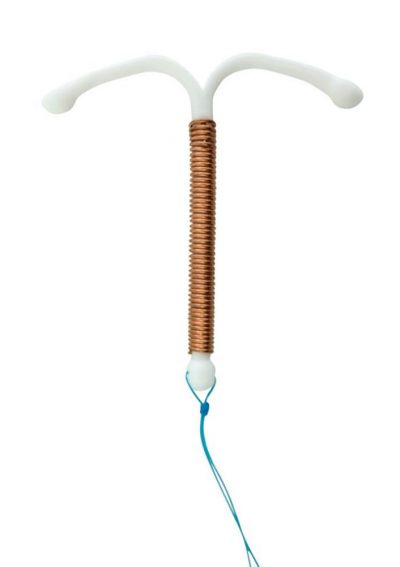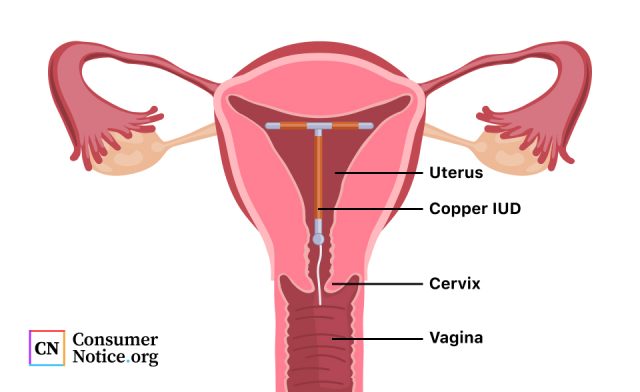Paragard
Paragard is a long-term form of birth control called an intrauterine device (IUD). It’s hormone free, and copper is its only active ingredient. The IUD lasts for up to 10 years. Side effects include abnormal uterine bleeding, heavier or longer periods and backache.

Paragard is the only hormone-free IUD available in the United States and it has been on the market since 1984. According to Cooper Surgical, the IUD’s manufacturer, Paragard has been proven safe and effective since its release.
Cooper markets the medical device as a convenient, no-hassle birth control device that is over 99 percent effective. Once in place, Paragard works for up to 10 years and can be removed any time a woman wishes to conceive.
Most insurance plans cover Paragard, and it’s available at little to no cost out of pocket, according to Planned Parenthood.
How Does Paragard Work?
Paragard is a small, flexible, T-shaped plastic device with copper wrapped around it. The implant’s stem is about 1.42 inches tall and its arms measure about 1.26 inches across. It has strings attached to it for easy removal.
Unlike other IUDs such as Skyla and Mirena, Paragard doesn’t contain hormones. It doesn’t prevent ovulation or stop a woman’s period. Instead, it uses copper to prevent pregnancy.
Once implanted in the uterus, the copper on the device interferes with the movement of sperm and prevents fertilization of the egg. It may also prevent the egg from attaching to the uterine wall, a process called implantation.

Insertion and Removal
Paragard insertion and removal are outpatient procedures that don’t require surgery or general anesthesia. Some providers may use a local anesthetic.
Each procedure takes only a few minutes in a medical provider’s office or clinic. Women can usually go home a few minutes after implantation or removal.
Insertion
After an examination to determine the position of the uterus, the medical provider will clean the vagina and cervix and measure the uterus.
The provider will then load the IUD into a plastic tube and insert the tube into the uterus. The IUD has flexible arms that extend once it’s deployed into the uterus. Then, the provider removes the tube, leaving the IUD in place.
The provider will trim the threads so they extend a little bit out of the cervix. They are just long enough for a patient to check them during a self-check.
Some women may experience discomfort during insertion. This includes cramping, pinching, dizziness, nausea and a sensation of feeling faint. Most symptoms go away quickly after insertion, but cramping can last for a few hours to a few days.
Removal
Paragard removal takes only a few minutes in a medical provider’s office. The provider will use an instrument to grasp the exposed threads and gently pull downward. The Paragard’s arms will fold up during removal, allowing it to come out of the uterus.
Some women may feel some discomfort during removal, but it only lasts a few minutes. Some bleeding, dizziness, slow heartbeat or rare seizures may occur during removal, according to the prescribing information. Rarely, Paragard may become stuck and surgery may be required to remove it.
Complications and Side Effects
Because Paragard uses copper as its active ingredient instead of hormones, it doesn’t cause weight gain. Like most IUDs, Paragard is generally safe for most people, but it has a few potential side effects.
- Vaginitis
- Spotting in between periods
- Partial or complete expulsion
- Painful periods
- Pain during sex
- Pain
- Heavier or longer than normal periods
- Cramping
- Backache
- Anemia
Serious Side Effects
Common side effects with Paragard are usually not serious. But rarely, serious problems can occur. These include pregnancy outside of the uterus (ectopic pregnancy), severe infections, septic abortion, perforation or embedment in the uterus and pelvic inflammatory disease.
Paragard isn’t for everyone. Don’t use Paragard if you have an active infection, suspect you have cancer, have pelvic inflammatory disease or are allergic to copper or other components of the IUD.
While Paragard is made of copper, there has been no sufficient evidence to suggest it causes copper poisoning or toxicity.
Lawsuits
Women have filed Paragard lawsuits because the IUD can break during removal and cause complications such as pain, perforation of the uterus or cervix and infertility. Many women required surgery to remove the broken pieces.
Women allege Cooper Surgical failed to warn them about the risk of complications from Paragard breakage during removal. The lawsuits also claim Paragard is defective.
The Judicial Panel on Multidistrict Litigation consolidated several lawsuits from across the country in the Northern District of Georgia under Judge Leigh Martin May in December 2020.
4 Cited Research Articles
Consumernotice.org adheres to the highest ethical standards for content production and references only credible sources of information, including government reports, interviews with experts, highly regarded nonprofit organizations, peer-reviewed journals, court records and academic organizations. You can learn more about our dedication to relevance, accuracy and transparency by reading our editorial policy.
- Cooper Surgical. (2020, February). Paragard Prescribing Information. Retrieved from https://14wub23xi2gmhufxjmvfmt1d-wpengine.netdna-ssl.com/wp-content/uploads/2018/10/PARAGARD-PI.pdf
- Cooper Surgical. (n.d.). What is Paragard? Retrieved from https://www.paragard.com/what-is-paragard/
- Planned Parenthood. (n.d.). How much does an IUD cost? Retrieved from https://www.plannedparenthood.org/learn/birth-control/iud/how-can-i-get-an-iud
- United States Judicial Panel on Multidistrict Litigation. (2020, December 16). Transfer Order. Retrieved from https://www.jpml.uscourts.gov/sites/jpml/files/MDL-2974-Transfer%20Order-12-20.pdf
Calling this number connects you with a Consumer Notice, LLC representative. We will direct you to one of our trusted legal partners for a free case review.
Consumer Notice, LLC's trusted legal partners support the organization's mission to keep people safe from dangerous drugs and medical devices. For more information, visit our partners page.
844-891-3125

